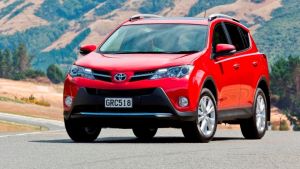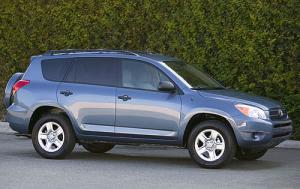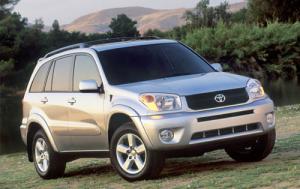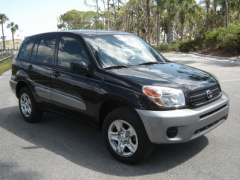"Older" vehicles are making more and more sense as used car prices have skyrocketed, and in particular, those with relatively low mileage ... and they are out there ... and those with strong reputations for reliability.

I often find some driven an easy 6 or 7 thousand miles a year, and sometimes less. They offer a very good way to save money in today's extremely high-priced market. But again, as long as the reliability is there.
And it's no secret that the Toyota RAV4 has a strong reputation for reliability across its generations. Toyota's commitment to quality and reliability has been a hallmark of their vehicles, and the RAV4 is no exception.
In fact, history has proven that a well-maintained RAV4 can be expected to last between 200,000 miles and 250,000 miles on average, and with even higher numbers for owners who really pamper their vehicles.
So here, ...
- We'll review the features of several older RAV4 generations.
- As well as the possible mechanical issues reported by some owners to be on the lookout for, because even Toyotas can experience them.
- And then summarize the overall pros and cons of an older RAV4 worth consideration.
Older Toyota RAV4 Overview
The RAV4 is yet another versatile and top quality vehicle from Toyota and has always been one of the best compact SUVs on the market.
The RAV4 is the smallest of Toyota's rather large lineup of SUVs and was one of the first crossover SUVs available. This has enabled the RAV4 to benefit from years of refinement and develop many best-in-class attributes.
We think they're a great alternative for SUV shoppers who don't need quite the typical SUV bulk and space. Even so, we find the interior space in the RAV4 to be quite adequate for most needs.
Pluses also include fairly economical prices, good fuel economy, excellent maneuverability, a high level of quality and easy driving.
Most drivers will be satisfied with its very capable four-cylinder engine ... and its excellent gas mileage. But there is also a V6 for those seeking additional power.
Toyota RAV4 Fourth Generation (2013 - 2018)

This generation underwent significant changes from its predecessor in both design and functionality. The fourth-gen RAV4 adopted a more aggressive and streamlined design compared to the previous generation. It showcased sharper lines, a sloping roofline, and a more aerodynamic profile.
And in size, the vehicle was slightly shorter in length but wider, giving it a more robust and muscular appearance.
The fourth-gen RAV4 was available in several trim levels, including LE, XLE, Limited, and SE. Additionally, there was a RAV4 Hybrid version introduced in this generation, catering to the increasing demand for fuel-efficient SUVs.
Its more popular features include the Entune Infotainment System which offered features like Bluetooth connectivity, app integration, and navigation in higher trims, it's standard rearview camera, the power liftgate, and advanced safety features in the higher trims such as blind-spot monitoring, rear cross-traffic alert, and lane departure warning.
The standard engine was a 2.5-liter four-cylinder engine producing around 176 horsepower and paired with a six-speed automatic transmission. The RAV4 Hybrid variant featured a combination of a 2.5-liter four-cylinder engine with an electric motor, providing improved fuel efficiency and delivering a total output of around 194 horsepower.
Overall, the fourth-generation Toyota RAV4 marked a significant evolution from its predecessor, offering a more modern design, enhanced features, and the introduction of a hybrid version, catering to a broader range of consumers with varied preferences in the SUV market.
2013 - 2018 Toyota RAV4 Possible Mechanical Problems
The RAV4, like any vehicle, has had a few reported issues during this 4th generation. However, it's important to emphasize that these problems have generally been sporadic and not widespread. Reported mechanical issues that should be included in a pre-purchase inspection include:
Transmission Issues: Some drivers experienced problems with the transmission, such as rough shifting or hesitation, particularly in earlier model years.
You May Also Like:
How To Get The Best Price On A New Toyota
Do This For The Best Trade-In Price
The Truth About Wholesale And Trade-in Values
Excessive Oil Consumption: Certain RAV4s experienced higher-than-normal oil consumption, which could lead to engine issues if not monitored and addressed.
Suspension and Steering Problems: A few owners reported issues with the suspension system or steering components, including noises or premature wear in suspension parts.
Water Pump Failure: In some cases, the water pump on the RAV4 failed prematurely, causing overheating issues.
Electrical System Glitches: Instances of minor electrical system glitches or malfunctions, such as issues with the infotainment screen or electrical controls, were reported by a few drivers.
Toyota RAV4 Third Generation (2006 - 2012)

The third-generation RAV4 is larger than its predecessors and can be found in Base, Sport and Limited models, with either a four-cylinder or V6 engine, and either front-wheel drive or all-wheel-drive. The standard transmission is a 4-speed automatic for the four-cylinder and a 5-speed automatic for the V6.
It has also grown to nearly the length of Toyota's midsize Highlander while its 3.5-liter V6 is actually more powerful, producing a hefty 269 horsepower. Still, due to its narrower width and overall lighter weight, it has the advantages of being easier to park and gets better gas mileage when similarly equipped. In fact, it's one of the most fuel efficient V6's in its segment.
The four-cylinder is a 2.5-liter that produces 179 horsepower, surprisingly good acceleration and excellent fuel mileage performance. And with either engine, the steering is light and responsive while the brakes are strong. When properly equipped, RAVs with the V6 have a towing capacity of a very respectable 3,500 pounds.
2006 - 2012 Toyota RAV4 Possible Mechanical Problems
The third-generation Toyota RAV4 again generally maintained a solid reputation for reliability. However, like any vehicle, it did have some reported mechanical issues that should be checked prior to buying.
Excessive Oil Consumption: Some models experienced higher-than-normal oil consumption, leading to potential engine issues if not addressed promptly. This problem could result in engine knocking or other complications.
Transmission Problems: There were occasional reports of transmission issues, including harsh shifting or hesitation, especially in earlier model years.
Suspension Components: Some drivers reported premature wear or noise in suspension components, such as struts or shocks, which could affect ride quality and handling.
Water Pump Failure: A few instances were reported where the water pump failed prematurely, potentially leading to overheating issues.
Electrical System Glitches: Minor electrical malfunctions, such as problems with the power windows or audio system, were reported by a few drivers.
It's important to note that these issues were not widespread and affected only a fraction of RAV4 vehicles from this generation. And Toyota typically addressed these problems through recalls, service campaigns, or warranty repairs.
Toyota RAV4 Second Generation (2001 - 2005)

The second-generation RAV4 was also larger and more stylish than its predecessor and featured innovative removable second-row seats that allowed for significant cargo space flexibility.
The early versions were equipped with a 2.0-liter four-cylinder engine that produced 148 horsepower. In 2004, it was replaced with a 2.4-liter four-cylinder good for 160 horsepower. This improved acceleration significantly and both manual and automatic transmission models were available.
Again, overall this was a fun-driving vehicle with precise suspension tuning and excellent gas mileage ratings.
2001 - 2005 Toyota RAV4 Possible Mechanical Problems
The second-generation had a generally good reputation for reliability, but there were a few reported issues that some owners encountered that should be checked before buying. It is again important to note that these issues were not universal and were experienced by a minority of owners.
Excessive Oil Consumption: Some models experienced higher-than-expected oil consumption, which could lead to engine issues if not monitored and addressed regularly.
Transmission Problems: There were occasional reports of transmission issues, such as rough shifting or hesitation.
Rust Issues: In certain regions with harsh weather conditions or road salt usage, some owners reported rust problems, particularly around the rear wheel wells and undercarriage.
Suspension Components: Like in later generations, there were occasional reports of premature wear or noise in suspension components, such as struts or shocks, affecting ride quality and handling.
Electrical System Glitches: Minor electrical malfunctions, such as issues with power windows or interior lights, were reported by a few drivers.
Overall Older Toyota RAV4 Pros And Cons
Older Toyota RAV4 Pros

Reliability: Toyota RAV4s, especially older models, have a reputation for reliability. They often have sturdy builds and engines known to withstand high mileage if properly maintained.
Lower Cost: Older models generally come at a significantly lower price point compared to newer vehicles, saving a substantial amount of money upfront.
Lower Depreciation: Used cars, especially older ones, have undergone the steepest part of their depreciation curve. This means they might hold their value relatively well compared to newer cars going forward.
Proven Track Record: Older RAV4s have been on the road for a while, meaning there's a wealth of information available about their common issues and maintenance requirements, making it easier to anticipate potential risks and costs.
Overall Older Toyota RAV4 Cons
Potential Maintenance Costs: While RAV4s are known for reliability, older cars may need more frequent maintenance and repairs, which can add up over time, potentially offsetting the some or all of the upfront purchase savings.
Technological Outdatedness: Older models might lack the latest tech and safety features found in newer vehicles. This could include things like advanced driver-assistance systems, improved fuel efficiency, or modern infotainment systems.
Higher Fuel Consumption: Older models may not be as fuel-efficient as newer ones due to advancements in engine technology and efficiency standards.
Limited Warranty Coverage: Older cars might not come with a warranty or have limited coverage remaining, meaning any issues that arise might become the owner's responsibility.
 By Josh Rosenberg
By Josh Rosenberg